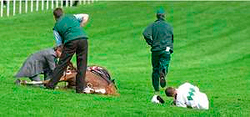Complete titel:
Sudden Cardiac Death in horses, K+ currents and cardiac repolarization in the horse - From genetics to clinic
Projektleder: Lektor Rikke Buhl, e-mail: rib@sund.ku.dk
The pumping function of the heart is exclusively controlled by electrical signals. It is vital that these signals are regulated and conducted precisely across the heart. Any kind of irregularities will fuel the occurrence of uncoordinated heartbeats (arrhythmias) which can cause fainting or in worst case sudden cardiac death.
In horses there is little knowledge about the electrical properties of the heart. One publication confirms the presence of K+ channels (of KCNQ1 and KCNH2 type) in the heart cells. In the heart the KCNQ1 and KCNH2 channels are responsible for the relaxation of the heart muscle after a contraction. In rodents and humans these channels are well characterized and it is known that mutations within the genes encoding these channels will cause delayed relaxation of the heart muscle – called long QT-syndrome (LQTS). Patients with LQTS have an increased risk of experiencing syncope or sudden cardiac death especially in combination with strenuous exercise. In horses exercise-related collapse or death is relatively common but is often undiagnosed.
We postulate that KCNQ1 and KCNH2 channels are present and functional in the equine heart and we also suspect that many sudden cardiac deaths in horses can be assigned to LQTS.
In this project we therefore want to find, clone and characterize the equine KCNQ1 and KCNH2 channels. In addition we wish to describe normal repolarizing time intervals of the equine heart. This will make it possible via ECG measurements to assign suspected LQTS horses to genetic testing and exclude them from the breading programme.
Perspectives of the project
We wish to develop a specific description of the repolarizing events in the equine heart and prove the occurrence of LQTS in horses. Hereby we wish to decipher the repolarizing events as depictured in the ECG T-wave trace and use this to distinguish between different types of LQTS based solely on ECG.
Ultimately we would like to expand the project and potentially use the horse as a model for human LQTS.
Partners on the project
- PhD student Philip Juul Pedersen, Department of Veterinary Clinical and Animal Sciences, Faculty of Health and Medical Science, University of Copenhagen
- Professor Dan Klærke, Department of Veterinary Clinical and Animal Sciences, Faculty of Health and Medical Science, University of Copenhagen
- Assoc. Professor Jørgen K. Kanters, Laboratory of Experimental Cardiology, DARC, Faculty of Health and Medical Sciences, University of Copenhagen
- Post Doc Dagmar Trachsel, Department of Large Animal Sciences, Faculty of Health and Medical Science, University of Copenhagen.
 Fig 1. Sudden cardiac deaths and syncopes are unacceptable events in horses seen from an ethical, financial and safety point of view. Up to 68% of sudden death events in racehorse do not have lesions sufficient to account for the death on necropsy and are suspected of exercise-induced acute cardiovascular failure.
Fig 1. Sudden cardiac deaths and syncopes are unacceptable events in horses seen from an ethical, financial and safety point of view. Up to 68% of sudden death events in racehorse do not have lesions sufficient to account for the death on necropsy and are suspected of exercise-induced acute cardiovascular failure.
